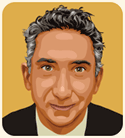The election guessing game in Peru has ended and now the Humala guessing game has begun: Will Ollanta Humala be the Peruvian equivalent of Venezuela’s Chávez or Brazil’s Lula? The answer, on which may hang Peru’s torrid rates of economic growth—among the highest in the region—and web of free-trade agreements with everyone from China to the United States, has become a parlor game for investors and observers, as we all watch whom Humala nominates to his cabinet. More than the people he chooses to populate his first round of appointments, the answer may actually lie in his formation as a military officer.
When he first ran for president in 2006, Humala professed his admiration for Venezuelan President Hugo Chávez; he even campaigned in the trademark-Bolivarian red tee shirt. Only five years later, the one-time lieutenant colonel who led an uprising against former elected autocrat President Alberto Fujimori, claimed he was a moderate leftist in the mold of former Brazilian President Luiz Inácio Lula da Silva, who embraced markets and foreign investors and reduced poverty.
It’s not hard to understand why he shifted role models. In the intervening five years, President Chávez has gone from the leader of an anti-American bloc of countries during the years of President George W. Bush to the head of the most dysfunctional economy in the region, with rates of inflation this year likely topping 25 percent and an economy that, even with the spike in oil prices, will be one of the last to rise out of the region’s post-recession torpor. In contrast, President Lula, by hewing to a course of fiscal stability, appointing confidence-instilling technocrats and supporting both foreign investors and Brazilian companies, has both kept Brazil on a path of stable economic growth and—combined with innovative social policies—reduced the number of the Brazilian poor by up to 38 million. No mean feat.
The first round of elections in Peru shocked the country and the world. After what appeared to be enviable rates of economic growth and stability, a slim majority of voters rejected the center, aided in part by a three-way split between former Lima Mayor Luis Castañeda Lossio, former President Alejandro Toledo and former Prime Minister Pedro Pablo Kuczynski. In a vitiated party system, the center lost to two candidates on either side of the spectrum—Keiko Fujimori, the daughter of Alberto Fujimori who governed from 1990 to 2000 and is now jailed for corruption and human rights violations, and Humala.
As the second round approached, first-round loser Toledo and Peruvian Nobel Laureate Mario Vargas Llosa took what may someday be seen as a courageous move: they threw their political weight behind Humala. Both expressed their concerns, with Vargas Llosa famously describing the choice between Fujimori and Humala as a choice between AIDS and terminal cancer and Toledo admitting it was a jump into the abyss.
Their decision, should it succeed in moderating the course of Humala’s term, may have saved their country. While their support helped Humala win the election, it also helped to provide both an institutional guarantee for moderation. By adding the 21 seats that Toledo’s Perú Posible party won to the 47 seats that Humala’s Gana Perú party won in the 130-seat unicameral congress, Toledo provided a key link to Humala’s ability to govern—assuming he does so institutionally. Similarly, having supported President-elect Humala, Mario Vargas Llosa and his son Álvaro will provide an international bellwether for the course of Humala’s government. The one-time military officer may stray from his professed moderate course—but fortunately the world has such credible, objective voices to serve as arbiters.
I say this in part because the situation may likely become polarized, despite President-elect Humala’s promises to build a moderate, coalition government. There are those who will immediately impute any effort to increase taxes on international investors as a sign of creeping nationalization. And there are those who will likely turn a blind eye, believing that President Humala represents the lesser evil against a resurgent Fujimorista tide.
The truth is that while we should be vigilant against such encroachments of private property rights, there is legitimate scope for increasing the government’s take on high commodity prices. The risk in such situations is always that businesses use ready-made political allies to play Chicken Little and proclaim that the country is being subverted as a means to protect their own privileges. We’ll see (and I hope) that father and son Vargas Llosa—who enjoy respect among businesses, conservative circles and intellectuals—can serve as objective interpreters of Humala’s policy gyrations.
All this leaves the question of what President-elect Humala is all about. I don’t doubt that he can change his stripes and even jettison his unsavory family connections—including his father who espouses a form of racist ethno-nationalism and his coup-plotting brother. The larger question is if he can shed his own formation as a military officer. Humala says his model is now former President Lula. But Lula was a former trade union leader—a man who for years had spent his time negotiating, cutting deals and compromising when necessary.
My experience is that former military leaders don’t govern; they command. The question may not be whether the President-elect believes in the moderate economic policies of Lula, but whether he has the constitution to govern like him—or more like his comrade in arms Hugo Chávez.
*Christopher Sabatini is editor-in-chief of Americas Quarterly and senior director of policy at the Americas Society and Council of the Americas.




